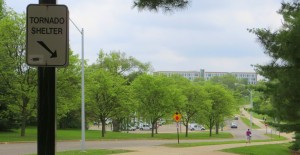An important part of academics’ work is attending conferences; think Presentation Skills meets Proseminar, or an MA Elective class, but with professors and researchers instead of students. While some of the best conferences are symposia with just a dozen or so papers, such as our own Linguistics Meets Book History last autumn, others are huge, with hundreds or thousands of participants. I went to a biggie in mid-May: the International Congress on Medieval Studies in Kalamazoo, Michigan.
If you work on anything to do with the Middle Ages, the Kalamazoo congress will be on your bucket list. Affectionately known as The Zoo, it is an annual event organised by the Medieval Institute at Western Michigan University. It is attended by 3000 medievalists each year, and this time the number of sessions was 567, each of them with three or more presentations, spread over three and a half days.

This was the first time I attended the congress, and I have to admit it was difficult to choose between so many intriguing-sounding parallel sessions. I tended to choose sessions which, one way or the other, focused on language; these were clearly in the minority as most of the speakers at The Zoo are historians rather than historical linguists. As much as you might learn from papers on topics that you are not that familiar with, it is often more useful to choose presentations which have some potential relevance for your own work. The clearly most linguistic session I attended was on polysemy in Old English, but I also went to three panels on translation, with papers on texts translated in the Middle Ages, translating medieval texts today, and on one occasion, not just rendering Chaucer in present-day language but also transmuting the Canterbury Tales into a comic book. One of my favourite sessions was a well-attended panel introducing some of the most ambitious projects for digitising medieval manuscripts; overall, Digital Humanities was quite prominent at the congress. My own paper on multilingual practices in post-Conquest England was in a less well-attended manuscripts session. As for the texts discussed at The Zoo, the English-language materials ranged from Beowulf to True Blood. For more on what went on at the congress, it is worth checking #kzoo2015 on Twitter.

Kalamazoo itself is the size of Joensuu and located a three-hour train ride from Chicago. My impression was that the town is known for three things: the Glenn Miller song from the 1940s, the range of local beers, and the university (might the last two be interconnected?). With 24,000 students, WMU is a good example of an American campus that is like a city within a city. The buildings are many, there are sports facilities and eateries, and in the middle there is a lovely green park complete with a pond (and swans). Many of the congress participants actually stayed on campus and slept in the dormitories. That part of the Kalamazoo experience I missed, as I stayed in a downtown hotel instead. Maybe next time?
Text and photos by Janne Skaffari